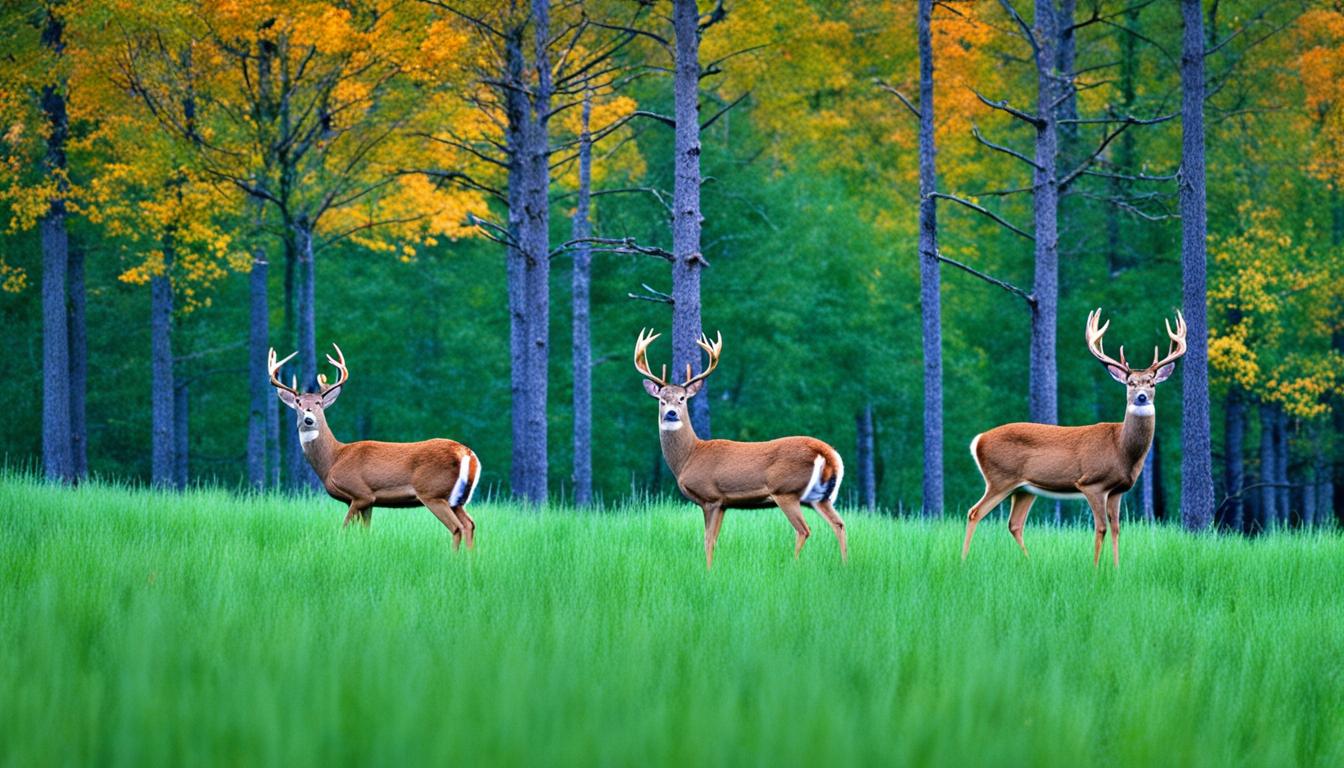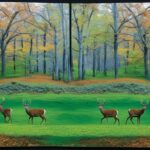Deer vision has long been a topic of debate among hunters and researchers. Many wonder if deer can see color or if they are colorblind. Luckily, numerous studies have shed light on this subject. While deer do have the ability to see colors, their perception differs from that of humans.
Deer have a higher concentration of rods, which are cells responsible for nighttime vision, compared to cones, which are cells responsible for daytime and color vision. This means that deer have superior vision in low-light conditions but poorer daytime and color vision compared to humans.
Deer possess two types of cone photopigments, allowing them limited color vision. They can differentiate short wavelength (blue) and middle wavelength (green) colors but are less sensitive to long wavelength colors like red and orange. Essentially, deer are red-green colorblind, similar to some humans.
Content Highlights
ToggleKey Takeaways:
- Deer can see colors but perceive them differently than humans.
- Deer have better nighttime vision but poorer daytime and color vision compared to humans.
- Deer are essentially red-green colorblind, like some humans.
Research has shown that deer have a higher sensitivity to colors in the blue spectrum, which is most abundant during dawn and dusk when they are most active. They can distinguish blue from red, but it is more challenging for them to differentiate green from red or orange from red.
Deer have an increased ability to see blues, up to 20 times better than humans. This is because deer lack a UV filter in their eyes, enabling them to see into the UV spectrum. However, their ability to see fine detail is compromised as they do not have a yellow filter like humans, which blocks UV and blue lights.
Deer have decreased clarity but heightened vision at dawn and dusk. Hunters should consider the impact of blue-spectrum light on deer vision when choosing their hunting clothing. Clothing that reflects blue light, such as blue jeans, can be more visible to deer than blaze orange.
Key Takeaways:
- Deer have a higher sensitivity to colors in the blue spectrum.
- Deer can see blues up to 20 times better than humans.
- Hunters should be cautious of clothing that reflects blue light, which may be more visible to deer.
The Importance of Blue-Spectrum Light and UV Brighteners for Deer
Research has revealed fascinating insights into how deer perceive color and the role it plays in their visual acuity. While deer possess limited color vision, they exhibit a higher sensitivity to colors within the blue spectrum, making it an important factor to consider when understanding their visual capabilities.
Deer can differentiate between blue and red colors, but they struggle to distinguish between green and red or orange and red. Interestingly, deer have a remarkable ability to see blues up to 20 times better than humans. This heightened sensitivity to blue colors can be attributed to the absence of a UV filter in their eyes, which allows them to perceive the UV spectrum.
However, the absence of a yellow filter, which humans possess, prevents deer from seeing fine details with clarity. The lack of a yellow filter compromises their vision but enhances their ability to perceive colors at dawn and dusk when blue light is abundant.

For hunters, understanding the impact of blue-spectrum light on deer vision is crucial when choosing appropriate hunting attire. Surprisingly, clothing that reflects blue light, such as blue jeans, can appear more vivid to deer compared to blaze orange, which hunters traditionally use for visibility purposes.
Moreover, hunters should exercise caution when selecting laundry products and clothing items with UV brighteners. These additives can cause clothing to appear “UV-hot” and more easily visible to deer, potentially compromising the effectiveness of camouflage.
In Summary:
| Insights | Implications |
|---|---|
| Deer have a higher sensitivity to blue colors and struggle to distinguish between green and red or orange and red. | Blue-spectrum light is more visible to deer, making clothing that reflects blue light more discernible to them. |
| Deer lack a UV filter, allowing them to perceive the UV spectrum. | Hunters should minimize the use of UV brighteners in clothing and laundry products to avoid increased visibility to deer. |
| The lack of a yellow filter compromises deer’s vision but enhances their ability to see colors at dawn and dusk. | Hunters should consider the lighting conditions during different hunting times to optimize their camouflage strategy. |
The Role of Movement and Overall Sensitivity in Deer Vision
While color vision is a factor in deer vision, it is important to note that movement and overall sensitivity play a larger role. Deer have excellent night vision due to their high concentration of rods and their oval-shaped pupils, which let in more light. They can detect even the slightest movements within their wide visual arc.
Additionally, deer have a heightened ability to detect movement at a distance and process it quickly. They can process what they see about 2.5 times faster than humans in low light and twice as fast in daylight. This sensitivity to movement is a survival mechanism that helps them detect predators and avoid potential threats.
Therefore, hunters should prioritize minimizing movement and remaining still to avoid detection by deer. The color of their clothing is relatively unimportant compared to scent, noise, and movement.
- California Deer Hunting Guide: Seasons, Rules, Permits, and More - 26 June 2024
- Arkansas Deer Season 2024 [Schedules, Licenses, Bag Limits & More!] - 26 June 2024
- 2024 Arizona Deer Season New Dates & Rules! - 25 June 2024




